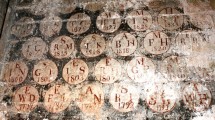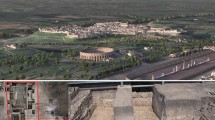Abstract
One hundred and eleven samples from the important Servilia Roman tomb have been analysed for the first time by Raman spectroscopy, resulting in a complete characterisation of the pigment palette used for its remarkable wall paintings: 73 different pigment mixtures have been identified for the composition of its 11 colours and their tonalities. Dyer’s weld, an ancient organic yellow pigment, which was described by Vitruvius, has been identified and characterised for the first time in Roman wall paintings. Distinctive Raman spectroscopic signals which differentiate between haematite and caput mortuum (a violet colour from haematite which has been subjected to thermal treatment) are also reported. The use of the very expensive lazurite for a balance relates the importance of this otherwise ordinary instrument with psychostasia (the human soul weighing process) and is not found elsewhere in the tomb. The distribution of white minerals alone or in admixture is not related to any particular colouring pigment or figure; this possibly indicates that there was no specific use for each white mineral and that several craftsmen worked on the paintings, perhaps in different periods, or that the frescoes have been subjected to unrecorded restoration. We conclude that Raman spectroscopy is a valuable analytical technique for the unambiguous identification of mixtures of both organic and inorganic compounds, to study the degree of mineral crystallinity and for identifying treatment. These data are relevant for the holistic interpretation of the artwork in its historical, economical and social context.











Similar content being viewed by others
References
Abad Casal L, Bendala Galán M (1975) La tumba se Servilia dela Necrópolis Romana de Carmona: su decoración pictórica. Habis 6:295–325
Abad Casal L (1982) Aspectos técnicos de la pintura mural romana. Lucentum 1:135–171
Aliatis I, Bersani D, Campani E, Casoli A, Lottici PP, Mantovan S, Marino IG, Ospitali F (2009) Green pigments of the Pompeian artists’ palette. Spectrochim Acta A 73:532–538
Apostolaki C, Perdikatsis V, Repuskou E, Brecoulaki H, Lepinski S (2006) Analysis of Roman wall paintings from ancient Corinth/Greece. In: Agioutantis Z, Komnitsas K (eds) Advances in mineral resources management and environmental geotechnology. Hania, pp 729–734
Baraldi P, Baraldi C, Curina R, Lassi T, Zannini P (2007) A micro-Raman archaeometric approach to roman wall paintings. Vib Spectrosc 43:420–426
Baraldi P, Bonazzi A, Giordani N, Paccagnella F, Zannini P (2006) Analytical characterization of roman plasters of the Domus Farini in Modena. Archaeometry 48(3):481–499
Béarat H, Fuch M (1996) Analyses physico-chimiques et minéralogiques de peintures murales romaines d’Aventicum. B l’Assoc Pro Aventico 38:35–49
Bearat H (1997) Quelle est la gamme exacte des pigments Romains? Confrontation des resultats d’analyse et de textes de Vitruve et the Pline. Proceedings of the International Workshop on Roman wall painting: materials, techniques, analysis and conservation. Fribourg: Institute of Mineralogy and Petrography
Bikiaris D, Daniilia S, Sotiropoulou S, Katsimbiri O, Pavlidou E, Moutsatsou AP, Chryssoulakis Y (1999) Ochre-differentiation through micro-Raman and micro-FTIR spectroscopies: application on wall paintings att Meteroa and Mound Athos, Greece. Spectrochim Acta A 56:3–18
Bläuer-Böhm C, Jägers E (1997) Analysis and recognition of dolomitic lime mortars. Proceedings of the international workshop on Roman painting: materials, techniques, analysis and conservation. Institute of Mineralogy and Petrography, Fribourg, pp. 223–235
Bouchard M, Smith DC (2003) Catalogue of 45 reference Raman spectra of minerals concerning research in art history or archaeology, especially on corroded metals and coloured glass. Spectrochim Acta A 59:2247–2266
Caballos Rufino A (2007) Carmona romana. In: Carmona, Sevilla: Ayuntamiento de Carmona. pp. 36–61
Corredor C, Teslova T, Cañamares MV, Chen Z, Zhang J, Lombardi JR, Leona M (2009) Raman and surface-enhanced Raman spectra of Chrysin, apigenin and luteolin. Vib Spectrosc 49:190–195
Cristache RA, Sandu I, Vasilache V, Cristache O (2013) Study of archaeometric characteristics of a panel painted icon from XIX century. Acta Chem Lasi 21(2):71–82
Cuesta A, Dhamelincourt P, Laureyns J, Martinez-Alonso A, Tascon JMD (1994) Raman microprobe studies on carbon materials. Carbon 32:1523–1532
de Faria D, Venâncio Silva S, de Oliveira MT (1997) Raman microspectroscopy of some iron oxides and oxyhydroxides. J Raman Spectrosc 28:873–878
de la Roja JM, Baonza VG, San Andrés M (2007) Application of Raman microscopy to the characterization of different verdigris variants obtained using recipes from old treatises. Spectrochim Acta A 68:1120–1125
de Oliveira LFC, Edwards HGM, Frost RF, Kloprogge JT, Middleton PS (2002) Caput mortuum: spectroscopic and structural studies of an ancient pigment. Analyst 127:536–541
Deldicque D, Rouzaud JN, Velde B (2016) A Raman-HRTEM study of the carbonization of wood: a new Raman-based paleothermometer dedicated to archaeometry. Carbon 102:319–329
Duran A, Jimenez de Haro MC, Perez-Rodriguez JL, Franquelo ML, Herrera LK, Justo A (2010) Determination of pigments and binders in Pompeian wall paintings using synchrotron radiation-high resolution X-ray powder diffraction and conventional spectroscopy chromatography. Archaeometry 52(2):286–307
Eastaugh N, Walsh V, Chaplin T, Siddall R (2004) Pigment compendium: a dictionary of historical pigments, 1st edn. Elsevier, Butterworth-Heinemann, Oxford
Edreira MC, Feliu MJ, Fernández-Lorenzo C, Martín J (2003) Spectroscopic analysis of roman wall paintings from Casa del Mitreo in emerita Augusta, Mérida, Spain. Talanta 59:1117–1139
Edwards HGM, de Oliveira LFC, Middleton P, Frost RL (2002) Romano-British wall-paintin fragments: a spectroscopic analysis. Analyst 127:277–281
Edwards HGM, Farwell DW, Rull Perez F, Jorge Villar SE (1999) Spanish Mediaeval frescoes at Basconcillos del Tozo: a Fourier transform Raman spectroscopic study. J Raman Spectrosc 30:307–311
Edwards HGM, Middleton PS, Hargreaves MD (2009) Romano-British wall paintings: Raman spectroscopic analysis of fragments from two urban sites of early military colonisation. Spectrochim Acta A 73:553–560
Edwards HGM, Middleton PS, Jorge Villar SE, de Faria D (2003) Romano-British wall-paintings II: Raman spectroscopic analysis of two villa sites at Nether Heyford, Northants. Anal Chim Acta 484:211–221
Favaro M, Guastoni A, Marini F, Bianchin S, Gambirasi A (2012) Characterization of lapis lazuli and corresponding purified pigments for a provenance study of ultramarine pigments used in works of art. Anal Bioanal Chem 402:2195–2208
Fermo P, Piazzalunga A, de Vos M, Andreoli M (2013) A multi-analytical approach for the study of the pigments used in the wall paintings from a building complex on the Caelian Hill (Rome). Appl Phys A Mater Sci Process 113:1109–1119
Fernández Díaz A (2010) Pintura. In: León Alonso P (ed) Arte romano de la Bética. Mosaico. Pintura. Manufactura, Sevilla, pp 191–274
Gaspar H, Moiteiro C, Turkman A, Countinho A, Carnide V (2009) Influence of soil fertility on dye flavonoids production in weld (Reseda luteola L.) accessions from Portugal. J Sep Sci 32:4234–4240
Guiral Pelegrín C (2002) Tumbas pintadas de la Hispania Romana. In: Vaquerizo Gil D (ed) Espacios y Usos Funerarios en el Occidente Romano, vol. II. Córdoba, pp. 81–104
Guiral Pelegrín C, Mostalac Carrillo A (2001) Las pinturas de las tumbas de Tito Urio y Servilia de la Necrópolis romana de Carmona (Sevilla, España). In: Barbet A (ed) La Peinture funéraire antique. Ve siècle av. J.-C.-IVe siècle ap. J.-C, Paris, pp 181–185
Gutman M, Lesar Kikelj M, Zupanek B, Kramar S (2016) Wall paintings from the Roman Emona (Ljubljana, Slovenia): characterization of mortar layers and pigments. Archaeometry 58(2):297–314
Hanesch M (2009) Raman spectroscopy of iron oxides dn (oxy)hydroxides at low laser power and possible applictions in enviromental magnetic studies. Geophys J Int 177:941–948
Jurasekova Z, Domingo C, Garcia-Ramos JV, Sanchez-Cortes S (2008) In situ detection of flavonoids in weld-dyed wool and silk textiles by surface-enhanced Raman scattering. J Raman Spectrosc 39:1309–1312
Jurasekova Z, Garcia-Ramos JV, Domingo C, Sanchez-Cortes S (2006) Surface-enhanced Raman scattering of flavonoids. J Raman Spectrosc 37:1239–1241
Legodi MA, de Waal D (2007) The preparation of magnetite, goethite, hematite and maghemite of pigment quality from mill scale iron waste. Dyes Pigments 74:161–168
Ling R (1991) Roman painting, 1st edn. Cambridge University Press, Cambridge
Mazzocchin GA, Agnoli F, Mazzocchin S, Colpo I (2003) Analysis of pigments from roman wall paintings found in Vicenza. Talanta 61:565–572
Mazzocchin GA, Agnoli F, Salvadori M (2004) Analysis of Roman age wall paintings found in Portenone, Trieste and Montegrotto. Talanta 64:732–741
Mazzocchin GA, Vianello A, Mingchelli S, Rudello D (2010) Analysis of Roman wall paintings from the Thermae of “Iulia Concordia”. Archaeometry 52:644–655
Millar W (2015) Plastering. Plain and decorative. Routledge, New York
Mostalac Carrillo A (1999) La pintura romana en Hispania de Augusto a Nerón. Madrider Mitteilungen 40:168–188
Ospitali F, Bersani D, Di Lonardo G, Lottici PP (2008) “Green earths”: vibrational and elemental characterization of glauconites, celadonites and historical pigments. J Raman Spectrosc 39:1066–1073
Paradisi A, Sodo A, Artioli D, Botti A, Cavezzali D, Giovagnoli A, Polidoro C, Ricci MA (2012) Domus Aurea, the “Sala delle Maschere”: chemical and spectroscopic investigations onthe fresco paintings. Archaeometry 54(6):1060–1075
Prieto-Taboada N, Gomez-Laserna O, Martinez-Arkarazo I, Olazabal MA, Madariaga JM (2014) Raman spectra of the different phases in the CaSO4-H2o system. Anal Chem 86:10131–10137
Rodríguez Hidalgo JM (2001) La tumba de Servilia. Nuevas aportaciones y revisión crítica. In: Caballos Rufino A (ed) Carmona Romana, Sevilla, pp. 189–202
Rodríguez Temiño I (2016) La pintura romana como evidencia de la espiritualidad clásica en la Necrópolis Romana de Carmona. In: X Congreso de Historia de Carmona, Sevilla, pp. 119–141
Rodríguez Temiño I, Jiménez Hernández A, González Acuña D, Ruiz Cecilia JI (2012) Avance de las nuevas investigaciones en la Necrópolis Romana de Carmona. Spal 21:127–151
Ruiz Cecilia JI, Rodríguez Temiño I, Jiménez Hernández A, González Acuña D (2011) A tumba abierta. Una nueva mirada sobre la Necrópolis Romana de Carmona a través de viejas fotografías. Junta de Andalucía, Sevilla
Salvadó N, Butí S, Aranda MAG, Pradell T (2014) News insights on blue pigments used in fifteenth century paintings by synchrotron radiation-based micro-FTIR and XRD. Anal Methods 6:3610–3621
San Andrés M, de la Roja JM, Baonza VG, Sancho N (2010) Verdigris pigment: a mixture of compounds. Imput from Raman spectroscopy. J Raman Spectrosc 41:1468–1476
Villar SEJ, Edwards HGM (2005) An extensive colour palette in roman villas in Burgos, Northern Spain: a Raman spectroscopic analysis. Anal and Bioanal Chem 382:283–289
Author information
Authors and Affiliations
Corresponding author
Rights and permissions
About this article
Cite this article
Jorge-Villar, S.E., Rodríguez Temiño, I., Edwards, H.G.M. et al. The Servilia tomb: an architecturally and pictorially important Roman building. Archaeol Anthropol Sci 10, 1207–1223 (2018). https://doi.org/10.1007/s12520-016-0450-9
Received:
Accepted:
Published:
Issue Date:
DOI: https://doi.org/10.1007/s12520-016-0450-9




